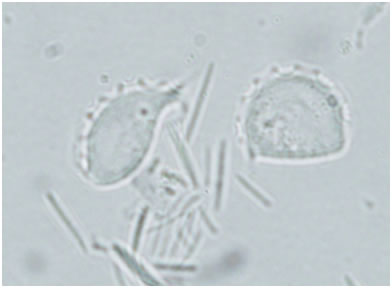Etiology: Tritrichomonas species (muris, minuta), Trichomitus wenyoni and Tetratrichomonas microti are protozoa which infect rats.
Incidence: The incidence of infection is common.
Transmission: Fecal-oral transmission occurs via ingestion of pseudocysts.
Distribution: These protozoa inhabit the cecal and colonic lumens. They retrograde into the small intestine.
Clinical Signs: No clinical signs have been attributed directly to these organisms. Diarrhea may be exacerbated by the presence of these flagellates, however their role as contributors to disease is poorly defined.
Diagnosis: Diagnosis is made by gross examination and confirmed by histopathology.
Antemortem: Direct smear of feces, fecal PCR.
Postmortem: Wet mounts of cecal contents reveal slow moving, flagellated protozoa with an undulating membrane. Trichomonads move with a jerky, wobbly, undirected motion. Histopathologic examination may also be used to diagnose trichomonad infection.
Diagnostic morphology: Trophozoites are pear- to lemon-shaped with an undulating membrane and 3 (tri-) to 4 (tetra-) anterior flagella. There is NO true cyst form.

T. muris 16-26 x 10-14 µm
T. wenyoni 6-16 x 3-6 µm
T. minuta 4-9 x 2-5 µm